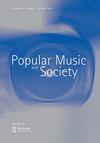光芒四射:鲍勃·迪伦的蜕变
IF 1
3区 艺术学
0 MUSIC
引用次数: 1
摘要
这张唱片专辑的构思注重曲目的顺序,并考虑到音乐的两个方面,有时是四个方面之间的休息。斯塔尔断言,测序的“潜在丰富主题”在Spotify和YouTube时代“可能看起来是一个遥远的时代错误”(89)。然而,毫无疑问,每个对迪伦感兴趣的人都会欣赏在有序的黑胶唱片中发现的“综合的、模式化的聆听体验”(92)。斯塔尔在这个话题上表现出色,他还将迪伦的编曲技巧扩展到了光盘中,并用《粗暴与Rowdy Ways》的大结局《谋杀最肮脏》来讨论迪伦将其放在一张单独的光盘上的原因,尽管第一张光盘上有可用的空间。这本书的倒数第二章对录音室和五首迪伦歌曲的多个现场版本之间的惊人变化进行了思考。斯塔尔将早期的主题编织到这些阅读中(迪伦的形式、声乐风格、乐器和伴奏,以及作者自己分析的不完整性),享受迪伦半个多世纪以来在舞台上唤起的“喜悦、惊讶、困惑、摇头和难以置信”(110)。迪伦“非凡而统一的创作”(111)的最后一章的结论性证据在《约翰娜的愿景》、《亲爱的房东》、《生活很艰难》和《你的梦》中得到了挖掘。听鲍勃·迪伦的话,语气舒缓,细节丰富,教会了我们鲍勃·迪伦更像是一个同步的问题,很快就认为歌词是迪伦的强项,也许你会意识到。声乐和器乐表演、结构、编排——这些项目,以及迪伦将它们结合在一起的方式,都以一种用户友好的方式进行了阐述,这将吸引广大观众。对于那些刚刚过了《最热门》和/或更可能下载他们的迪伦而不是翻唱LP或CD的人来说,斯塔尔在音乐、声音和交付方面的课程有很多收获。对于那些深入研究从谢尔顿到海林的学术,从鲍勃·迪伦到Bootleg系列的作品的人来说,有足够的内容可以思考。对于那些介于两者之间的人来说,学习鲍勃·迪伦卓越的歌曲创作、表演和作曲天赋会让他们感到无比快乐,正如拉里·斯塔尔在《听鲍勃·迪伦》中所展示的那样。本文章由计算机程序翻译,如有差异,请以英文原文为准。
Light Come Shining: The Transformations of Bob Dylan
that record albums were conceived with attention to the sequencing of tracks and with the breaks between two, sometimes four, sides of music in mind. The “potentially rich subject” of sequencing, Starr avers, “might seem a distant anachronism” (89) in the age of Spotify and YouTube. There’s little doubt, however, that everyone interested in Dylan will appreciate the “integrated, patterned listening experiences” (92) found in well-sequenced vinyl. Starr excels on this topic, extending Dylan’s skill at arrangement into compact discs as well, using “Murder Most Foul,” the finale of Rough and Rowdy Ways, to discuss Dylan’s reason for including it on a separate disc despite available space on the first disc. The book’s penultimate chapter offers thoughts on the startling changes between the studio and the multiple live versions of five Dylan songs. Starr weaves earlier themes into these readings (Dylan’s form, vocal style, instrumentation, and accompaniment, and the author’s own incompleteness of analysis), relishing the “delight, surprise, confusion, head-shaking, and disbelief” (110) Dylan has evoked on stage for more than half a century. Concluding evidence in the last chapter of Dylan’s “exceptional, and remarkably unified, creations” (111) is mined in “Visions of Johanna,” “Dear Landlord,” “Life Is Hard,” and “This Dream of You.” Listening to Bob Dylan, as soothing in tone as it is learned in detail, teaches us that Bob Dylan’s artistry is much more a matter of synchrony than we, quick to credit lyrics as Dylan’s forte, may realize. Vocal and instrumental performance, structure, arrangement – these items, and the way Dylan combines them, are explicated in a user-friendly manner that will appeal to a wide audience. For those not much past the Greatest Hits and/or more likely to download their Dylan than to mess with an LP or CD, there is much to gain from Starr’s lessons on music, sound, and delivery. For those deep into the scholarship from Shelton to Heylin and the oeuvre from Bob Dylan to the Bootleg Series, there is more than enough content to contemplate. And for those in-between, there awaits a surfeit of pleasure in learning about Bob Dylan’s supreme songwriting, performing, and composing gifts as illuminated by Larry Starr in Listening to Bob Dylan.
求助全文
通过发布文献求助,成功后即可免费获取论文全文。
去求助
来源期刊

POPULAR MUSIC AND SOCIETY
MUSIC-
CiteScore
1.10
自引率
0.00%
发文量
33
期刊介绍:
Popular Music and Society, founded in 1971, publishes articles, book reviews, and audio reviews on popular music of any genre, time period, or geographic location. Popular Music and Society is open to all scholarly orientations toward popular music, including (but not limited to) historical, theoretical, critical, sociological, and cultural approaches. The terms "popular" and "society" are broadly defined to accommodate a wide range of articles on the subject. Recent and forthcoming Special Issue topics include: Digital Music Delivery, Cover Songs, the Music Monopoly, Jazz, and the Kinks. Popular Music and Society is published five times per year and is a peer-reviewed academic journal supported by an international editorial board.
 求助内容:
求助内容: 应助结果提醒方式:
应助结果提醒方式:


